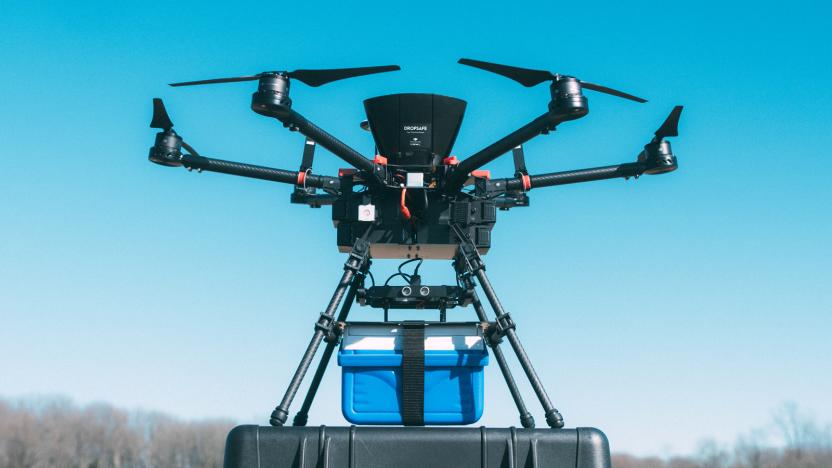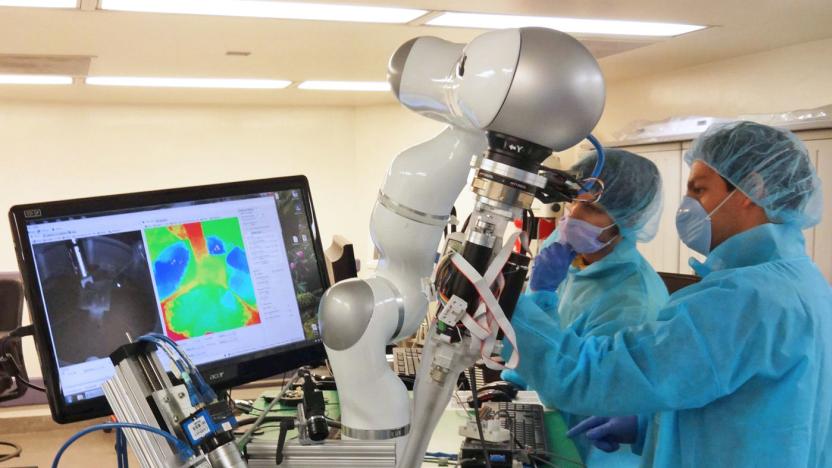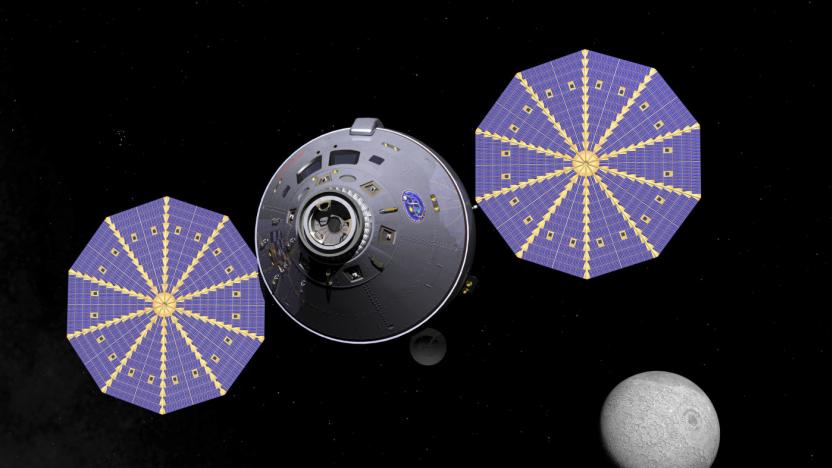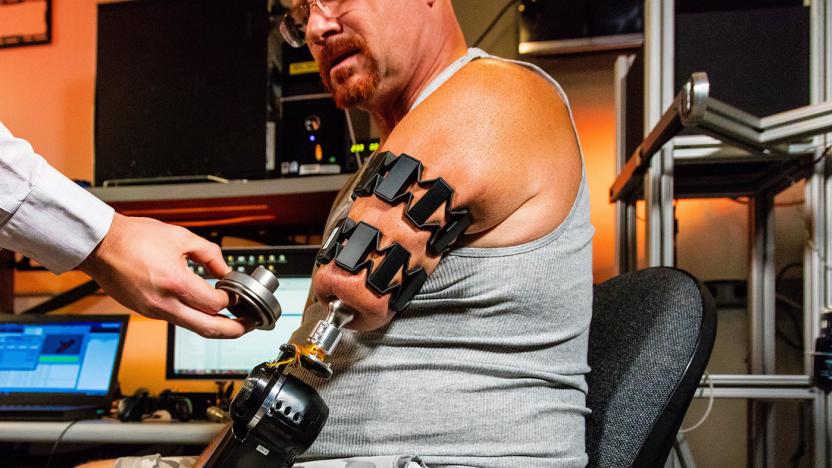johnshopkins
Latest

Amazon's Alexa Fellowship expands to 14 more universities
Amazon is eager to get more bright minds working on voice technology, so it's expanding the Alexa Fellowship program to 14 more universities, including Massachusetts Institute of Technology, Texas A&M and Cambridge. The fellowships are financed through Amazon's $200 million Alexa Fund.

Johns Hopkins performs the first total penis and scrotum transplant
The first US penis transplant was successfully performed in 2016. Last year, a uterus transplant recipient gave birth for the first time in the US, too. Now, doctors at Johns Hopkins University have successfully transplanted an entire penis and scrotum to a young serviceman who sustained injuries in Afghanistan resulting in the loss of his genitals.

A quadrocopter could be used to explore Saturn's largest moon
Back in 2014, NASA proposed using drones to explore Saturn's largest moon, Titan. Well, three years later, Johns Hopkins Applied Physics Lab has a pitch for the aeronautics agency. Like NASA suggested a few years ago, Hopkins' craft is a quadrocopter. The school said that its Dragonfly drone is ideal for exploring the moon given its dense atmosphere and weak gravity, making it "perfect" for heavier-than-air flight. "A human could actually strap on wings, flap their arms and fly," Peter Bedini says in the video below.

Drones can safely carry blood bags
Paramedics and rescue teams can't always afford to wait for blood supplies, especially when they're in remote locations where most vehicles would take too long (or can't visit at all). However, they might not have to worry for much longer. Johns Hopkins researchers have determined that it's safe to carry large bags of blood products (such as transfusions) using drones. In a study, they discovered that the robotic fliers didn't affect the chemical, hemotological or microbial traits of samples flown at an altitude of 328 feet, even when carrying it as far as 12 miles away. So long as the blood is kept in a temperature-monitored cooler, it's usable almost right away.

ICYMI: Hawaiian crows are our new favorite animal
try{document.getElementById("aol-cms-player-1").style.display="none";}catch(e){}Today on In Case You Missed It: Scientists filmed young Hawaiian crows and discovered that they're so smart, they figured out how to use tools to get food without ever having been taught by adult crows. There are very few Alala in the world, but some are about to be released back into the wild so researchers are excited they'll bring their stick engineering ways with them.

Surgical robot could sew you up better than a doctor
Surgical teams aren't fond of robots that could replace them (just ask Johnson & Johnson), but that doesn't mean they're completely against mechanical helpers. Children's National Medical Center and Johns Hopkins University recently tested a Smart Tissue Autonomous Robot (STAR) arm during experimental bowel surgery on anesthetized pigs. The machine only handled suturing by itself, but excelled at that job -- it sewed more consistently than veteran doctors and even other robotic assistants. Its edge comes from using a depth-savvy light field camera to find fluorescent markers placed inside the tissue, helping it spot folds that would normally stay hidden.

Johns Hopkins' drone flies straight from an underwater station
A UAV developed by a Johns Hopkins University Applied Physics Lab team can stay underwater for months, waiting out of sight until it's called to duty. When the machine does get deployed, it can swim up and fly into the air, just like any other quadcopter. The team calls their creation the KRAKENS CRACUNS or Corrosion Resistant Aerial Covert Unmanned Nautical System, made using additive manufacturing (3D printing) and other techniques. It can stay submerged hundreds of feet beneath the water's surface, thanks to its composite airframe that can withstand the pressure.

NASA picks solar power candidates for deep space missions
NASA is going to need solar power if it wants to keep its future deep space missions running, and that means getting someone to build that light-gathering technology. Fortunately, the agency has some partners lined up. It just picked four solar power technology proposals that could find their way into spacecraft traveling as far as Mars. The outfits negotiating deals are definitely ones you'll know -- ATK, Boeing, Johns Hopkins University and NASA's own Jet Propulsion Laboratory are all developing systems that collect solar energy in the unforgiving conditions beyond Earth.

Here's why the surface of Mercury is so dark
For years, scientists have wondered why Mercury is so dark. It doesn't have as much iron and titanium as the Moon, so it should be brighter. A team at Johns Hopkins' Applied Physics Laboratory finally has the answer, though. Thanks to a spectral analysis of color images from NASA's Messenger probe, they've determined that carbon (specifically, graphite) is the probable culprit behind Mercury's dim look. Most likely, what you're seeing is the aftermath of the tiny planet growing up. As the young Mercury's magma ocean cooled 4.6 billion years ago, the graphite would have floated to the top and formed the original crust -- there just happens to be enough of it left to affect visibility.

ICYMI: 3D-printed ears, autonomous DARPA drones and more
#fivemin-widget-blogsmith-image-214941{display:none;} .cke_show_borders #fivemin-widget-blogsmith-image-214941, #postcontentcontainer #fivemin-widget-blogsmith-image-214941{width:570px;display:block;} try{document.getElementById("fivemin-widget-blogsmith-image-214941").style.display="none";}catch(e){} Today on In Case You Missed It: Wake Forest Institute for Regenerative Medicine scientists have 3D-printed living tissue that can be transplanted into living animals, most notably an ear that grew new cartilage and blood vessels once under the skin of a mouse for a few months.

Johns Hopkins grows tiny brains in petri dishes for lab testing
Most new drugs tested on mice don't work on humans, because we're "not 150-pound rats," says Johns Hopkins' Bloomberg School's Dr. Thomas Hartung. He and his team believe the "mini-brains" they've designed and grown in the lab are better test subjects for drug development, since they're derived from human cells. These mini-brains are truly tiny at 350 micrometers in diameter, or about the size of a housefly.

ICYMI: Mind-controlled prosthetics, architect ants and more
#fivemin-widget-blogsmith-image-459334{display:none;} .cke_show_borders #fivemin-widget-blogsmith-image-459334, #postcontentcontainer #fivemin-widget-blogsmith-image-459334{width:570px;display:block;} try{document.getElementById("fivemin-widget-blogsmith-image-459334").style.display="none";}catch(e){} Today on In Case You Missed It: Johns Hopkins University researchers surgically repositioned a patient's nerves and also implanted a prosthetic adapter to use mind control on his prosthetic arm. French researchers learned that common ants are able to communicate how something should be constructed by leaving pheromone-based instructions on whatever they're building. And the OneCook smart appliance works by having the fresh ingredients loaded into the cooker hybrid, then lets people control adjust the recipe and let it do the rest from an app. It just launched on Kickstarter.

Researchers use Myo muscle-sensing wearable for prosthetics
Controlling Call of Duty or flying a drone isn't all the Myo armband can do. Researchers at Johns Hopkins University are employing the muscle-sensing wearable for a different application: prosthetics. With two of the gadgets, a patient is able control a prosthetic arm when he thinks about it. The pair of Myo bands on the upper arm read the electric impulses from muscle movement and wirelessly transmit them to a nearby computer. That computer determines what movement he is trying to make and tells the prosthetic arm to complete the task.

America's first penile transplants will be for war veterans
Arms and legs aren't the only appendages that American servicemen lose to IEDs but, thanks to a pioneering surgical technique, injured soldiers will soon have the option of replacing their war-damaged wedding tackle. A team of surgeons from Johns Hopkins University School of Medicine announced on Sunday that within a year (more likely, just a few months) their facility will begin performing penis transplants. American veterans will be their first patients.

Apple introduces ResearchKit apps for autism, melanoma and epilepsy
Apple wanted to make data gathering easier for medical researchers with ResearchKit. According to the company, since the launch of the open-source platform earlier this year, over 100,000 participants have already shared their health data with a host of apps that study asthma, diabetes, breast cancer and more. The Kit's ever-increasing list of studies will now include autism, epilepsy and melanoma.

Double amputee controls two robotic arms with his mind
Here's one other DARPA-funded robotic limb controlled by thoughts alone -- actually make that two, because Colorado man Les Baugh had two bionic arms attached from shoulder level. Baugh got them this summer, 40 years after losing both arms, as part of a Revolutionizing Prosthetics Program test run at the Johns Hopkins Applied Physics Laboratory. The project's researchers have been developing these Modular Prosthetic Limbs (MPL) over the past decade, but they say Baugh is the "first bilateral shoulder-level amputee" to wear two MPLs at the same time. Unlike Jan Scheuermann who controlled a robotic arm with a pair of neural implants, though, Baugh had to undergo a procedure called targeted muscle reinnervation, which reassigned the nerves that once controlled his arms and hands.

Study proves that you can secretly hijack an older Mac's webcam
If you believe common wisdom, it shouldn't be possible to take over most webcams without alerting users. The indicator LED is supposed to be hack-proof, after all. However, a pair of Johns Hopkins researchers have recently published a research paper showing that it's possible to control the camera while keeping the indicator dark. Their proof-of-concept app, iSeeYou, reprograms a controller chip on pre-2009 Macs to separate the camera and LED functions; users can flick the light on and off like a switch. Apple is aware of the issue with its own systems, but it hasn't said whether or not there will be a fix. It's also unclear how many newer Macs or other PCs are at risk. Regardless of the exact threat, the study isn't very reassuring in an era of widespread surveillance -- if a pair of academics can stealthily record your activity, it's likely that professional spies can do the same.

Device warns of catastrophic failure in lithium-ion batteries, robots celebrate
"Catastrophic lithium-ion battery failure" are five words Malfunctioning Eddie never wants to hear, and may not have to, thanks to a new sensor developed by the folks at the Johns Hopkins University Applied Physics Laboratory. Despite the popularity of lithium-ion batteries in everything from consumer electronics to hybrid and electric vehicles, they have been associated with a phenomenon called "thermal runaway" -- known to cause overheating and potentially, fire. The newly developed device measures the electrical parameter of the cell, which is an indicator of whether the internal layer temperatures are getting too toasty. The best part? The warning comes before the heat can reach the surface and cause catastrophic failure, perhaps saving our electronics from a fate like the one in the video after the break.

DARPA setting up a $130 million 'virtual firing range' to help battle cyber attacks
The US government is serious about online security, just ask any one of its cyber commandos. Adding to its arsenal for battling the big bad hackers, Reuters reports that DARPA is working on a National Cyber Range, which would act a standalone internet simulation engine where digital warriors can be trained and experimental ideas tested out. Lockheed Martin and Johns Hopkins University are competing to provide the final system, with one of them expected to soon get the go-ahead for a one-year trial, which, if all goes well, will be followed by DARPA unleashing its techies upon the virtual firing range in earnest next year. The cost of the project is said to run somewhere near $130 million, which might have sounded a bit expensive before the recent spate of successful hacking attacks on high profile private companies, but now seems like a rational expenditure to ensure the nuclear missile codes and the people crazy enough to use them are kept at a safe distance from one another. DARPA has a pair of other cleverly titled cybersecurity schemes up its sleeve, called CRASH and CINDER, but you'll have to hit the source link to learn more about them.

da Vinci Robot pwns Operation, deems our childhoods forlorn (video)
What happens when a robot with immaculate dexterity comes to grips with a notorious board game from our childhood? Just ask Johns Hopkins University students, who successfully removed the wish bone from an Operation board using the da Vinci Robot. If you're familiar with the game, you'll know how incredibly difficult it was to prevent that ear-piercing noise from occurring-- even with our tiny fingers. Of course, we should have expected that a robot -- especially one capable of folding a tiny paper airplane -- would be able to accomplish this feat with such ease. Be sure to peep the pseudo-surgery in video form below the break.









